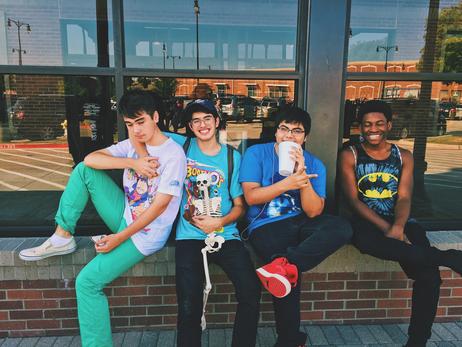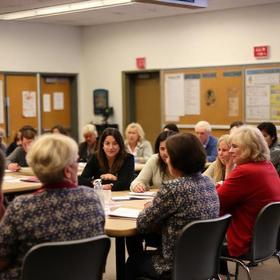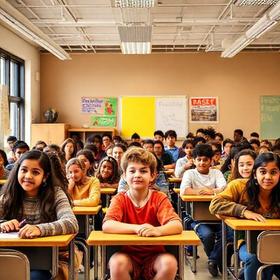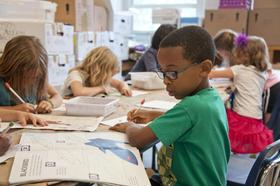American public schools have made tremendous progress since the Supreme Court declared school segregation unconstitutional in Brown v. Board of Education. Schools throughout the nation are more diverse than ever before as a result of desegregation, immigration of people to this country, and emigration of citizens from one region of the nation to another. Sixty years after the Supreme Court’s decision, schools in Alabama, Mississippi, Georgia and other southern states where segregation was once so prominent have shown great gains in diversity.
But which states have the most diverse public school campuses? We collected data and analyzed the numbers to develop an original list illustrating how much diversity truly exists in each state’s public schools.
Diversity Scores of Public Schools
To equally compare the diversity of public schools in our country, we mined student population data and calculated diversity scores at the school, town, county and state levels.
While “diversity” commonly refers to the presence of minorities, we were interested in understanding the presence of more than one ethnic group on campus. For example, while theLos Angeles Unified School District has many schools that have 90% or more Hispanic students on campus, this would be considered a homogenous school, rather than a diverse one.
As such, our formula determines the likelihood that any two students are from different ethnic groups. Scores closer to 1 indicate greater diversity, while scores closer to 0 indicate lesser diversity.
When examining the various levels of scoring, school-level scores are more or less indicative of the town, county and state-level scores, meaning states with a greater level of diversity also have schools with a greater level of diversity.
There are, of course, exceptions to the rule. Our data analysis takes the average across all of the schools, but there are always outliers.
.png)
For example, 93 percent of Vermont’s public school students are White, giving it a state-level diversity score of .14. Yet, the Integrated Arts Academy at H.O. Wheeler School in Burlington has a relatively high school diversity score of .6147 because of large numbers of Asian and Black students in that particular district. Similarly, Cattell Elementary School in Des Moines, Iowa, which has large populations of Asian, Black and Hispanic students, has a diversity score of .7644, whereas Iowa’s overall diversity score is just .32.
Despite these anomalies, more diverse schools tend to be in cities and states that have had existing ethnic populations for quite some time, or have experienced an influx of ethnic minorities in the last ten to twenty years.
Most Diverse States
Based upon our data, the 10 states with the most diverse public schools are:
1. Florida
2. Nevada
3. Maryland
4. New York
5. Illinois
6. New Jersey
7. Alaska
8. California
9. Georgia
10. Hawaii
It stands to reason that states with a more diverse general population would also have greater diversity in their public schools. Indeed, Nevada, Maryland, New York, Alaska, California, and Hawaii are counted in the top 10 most diverse states in America, according to the American Community Survey conducted in 2009.
However, Florida, Illinois, New Jersey, and Georgia – which appear in our top 10 most diverse public school states – are not among the top 10 most diverse states by the general population.
There are interesting trends to note when comparing the general population against that found on public school campuses. For example, New Mexico is the 6th most diverse state in the country, yet its public school population’s diversity ranks at 16th place. Washington state ranks 20th for its diversity on public school campuses, but is 10th for its general population’s diversity.
The discrepancy between diversity in public schools and the general population has several explanations. One is the increase in minority population growth amongst the student-aged residents of the state, as compared to the non-school aged population.

It comes as no surprise that states such as Florida and Nevada, both of which have seen explosive population growth over the last two decades, are at the top of the list in terms of public school diversity when examined at the state-level. Florida’s score of .69 is due in large part to increasing numbers of Hispanic students, who currently represent 27 percent of all Florida public school students. Florida schools have a large population of Black students as well, representing 23 percent of all students. Nevada’s Hispanic population has grown faster than most other states, and as a result, Hispanic students now represent 39 percent of Nevada’s students. Nevada’s state-level diversity score of .68 is reflective of this trend.
Another explanation for the discrepency of the general population vs. public school diversity is district lines. For the vast number of public schools, their student population is determined by geographical district lines. While a state may have a diverse general population, it may be segregated regionally, with some ethnic groups congregating in certain school districts.
There might also be preferences in different ethnic groups for enrollment in public vs. private schools. For exampe, while Los Angeles is one of the most racially diverse cities in America, 91% of the students enrolled in the Los Angeles Unified School District are minority students, mostly Hispanic. However, in analyzing the general population of Los Angeles County, only 57.5% are Hispanic, while 41.3% are White and 10.7% are Asian. A possible explanation is that a large portion of the White and Asian population attend private schools in the county.
th Hawaii State Department of Education California Department of Education
When examined at the town-level, the three towns with the most diverse schools in the nation are in the San Francisco-Oakland metro area. El Cerrito, El Sobrante and Pinole, California have diversity scores of .80, .79 and .79 respectively. In each city, schools have large populations of Asian, Black and Hispanic students. In fact, in each of these three California cities, no ethnic group represents more than 42 percent of any individual school’s overall population.
Data gathered at the district-level shows that California is also home to the most diverse school districts. Elk Grove Unified Public Schools and Natomas Unified School District, both of which serve students in the Sacramento area, and John Swett Unified School District in Contra Costa County all have diversity scores of .78. Schools in these districts have a larger percentage of minority students when compared to the California average, as well as generally fewer White students when compared to the state as a whole, which accounts for their high diversity scores.
Least Diverse States
The 10 states with the least diversity on their public school campuses are:
1. Vermont
2. West Virginia
3. Maine
4. New Hampshire
5. Montana
6. Kentucky
7. Iowa
8. Wyoming
9. North Dakota
10. Utah
With exception to Montana, Wyoming, and Utah, the other seven states in our list are also ranked as the top 10 most diverse states by general population, according to the American Community Survey from 2009.
States in regions that have shown stagnant overall population growth over the last ten years have the least amount of ethnic diversity in their schools. According to information from the U.S. Census Bureau, New England and the Midwest have the slowest overall growth of any region. New England grew by only 3.2 percent between 2000 and 2010, while the Midwest grew by just 3.9 percent. As such, statewide diversity scores for states in these areas are quite low. For example, Vermont, Maine and New Hampshire have three of the four lowest state-level diversity scores, with none being higher than .19.
Benefits of Diversity in Public Schools
Ethnic diversity in elementary and secondary schools provides students and teachers with a rich environment in which increased social interactions allow them to learn about other peoples, cultures and traditions. This, in turn, leads to understanding and respect for others. As reported by the Association for Psychological Science, students in highly diverse schools exhibit higher self-esteem, while having reduced feelings of loneliness. Students who attend schools with more diverse student bodies also report feeling safer in school and experience less peer-to-peer harassment.
In short, the more diverse the student population, the better students seem to feel. As the nation continues to grow and regions with less diverse populations attract more people, school diversity will continue to increase and so too will acceptance of others.
Questions? Contact us on Facebook @publicschoolreview.












